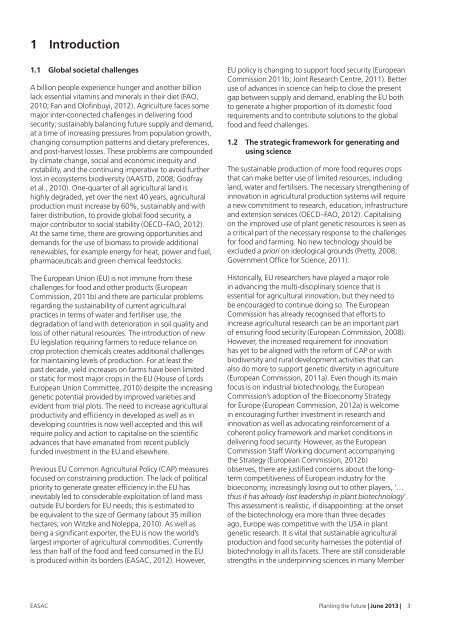Planting the future: opportunities and challenges for using ... - EASAC
Planting the future: opportunities and challenges for using ... - EASAC
Planting the future: opportunities and challenges for using ... - EASAC
Create successful ePaper yourself
Turn your PDF publications into a flip-book with our unique Google optimized e-Paper software.
1 Introduction<br />
1.1 Global societal <strong>challenges</strong><br />
A billion people experience hunger <strong>and</strong> ano<strong>the</strong>r billion<br />
lack essential vitamins <strong>and</strong> minerals in <strong>the</strong>ir diet (FAO,<br />
2010; Fan <strong>and</strong> Olofinbuyi, 2012). Agriculture faces some<br />
major inter-connected <strong>challenges</strong> in delivering food<br />
security; sustainably balancing <strong>future</strong> supply <strong>and</strong> dem<strong>and</strong>,<br />
at a time of increasing pressures from population growth,<br />
changing consumption patterns <strong>and</strong> dietary preferences,<br />
<strong>and</strong> post-harvest losses. These problems are compounded<br />
by climate change, social <strong>and</strong> economic inequity <strong>and</strong><br />
instability, <strong>and</strong> <strong>the</strong> continuing imperative to avoid fur<strong>the</strong>r<br />
loss in ecosystems biodiversity (IAASTD, 2008; Godfray<br />
et al., 2010). One-quarter of all agricultural l<strong>and</strong> is<br />
highly degraded, yet over <strong>the</strong> next 40 years, agricultural<br />
production must increase by 60%, sustainably <strong>and</strong> with<br />
fairer distribution, to provide global food security, a<br />
major contributor to social stability (OECD–FAO, 2012).<br />
At <strong>the</strong> same time, <strong>the</strong>re are growing <strong>opportunities</strong> <strong>and</strong><br />
dem<strong>and</strong>s <strong>for</strong> <strong>the</strong> use of biomass to provide additional<br />
renewables, <strong>for</strong> example energy <strong>for</strong> heat, power <strong>and</strong> fuel,<br />
pharmaceuticals <strong>and</strong> green chemical feedstocks.<br />
The European Union (EU) is not immune from <strong>the</strong>se<br />
<strong>challenges</strong> <strong>for</strong> food <strong>and</strong> o<strong>the</strong>r products (European<br />
Commission, 2011b) <strong>and</strong> <strong>the</strong>re are particular problems<br />
regarding <strong>the</strong> sustainability of current agricultural<br />
practices in terms of water <strong>and</strong> fertiliser use, <strong>the</strong><br />
degradation of l<strong>and</strong> with deterioration in soil quality <strong>and</strong><br />
loss of o<strong>the</strong>r natural resources. The introduction of new<br />
EU legislation requiring farmers to reduce reliance on<br />
crop protection chemicals creates additional <strong>challenges</strong><br />
<strong>for</strong> maintaining levels of production. For at least <strong>the</strong><br />
past decade, yield increases on farms have been limited<br />
or static <strong>for</strong> most major crops in <strong>the</strong> EU (House of Lords<br />
European Union Committee, 2010) despite <strong>the</strong> increasing<br />
genetic potential provided by improved varieties <strong>and</strong><br />
evident from trial plots. The need to increase agricultural<br />
productivity <strong>and</strong> efficiency in developed as well as in<br />
developing countries is now well accepted <strong>and</strong> this will<br />
require policy <strong>and</strong> action to capitalise on <strong>the</strong> scientific<br />
advances that have emanated from recent publicly<br />
funded investment in <strong>the</strong> EU <strong>and</strong> elsewhere.<br />
Previous EU Common Agricultural Policy (CAP) measures<br />
focused on constraining production. The lack of political<br />
priority to generate greater efficiency in <strong>the</strong> EU has<br />
inevitably led to considerable exploitation of l<strong>and</strong> mass<br />
outside EU borders <strong>for</strong> EU needs; this is estimated to<br />
be equivalent to <strong>the</strong> size of Germany (about 35 million<br />
hectares; von Witzke <strong>and</strong> Noleppa, 2010). As well as<br />
being a significant exporter, <strong>the</strong> EU is now <strong>the</strong> world’s<br />
largest importer of agricultural commodities. Currently<br />
less than half of <strong>the</strong> food <strong>and</strong> feed consumed in <strong>the</strong> EU<br />
is produced within its borders (<strong>EASAC</strong>, 2012). However,<br />
EU policy is changing to support food security (European<br />
Commission 2011b; Joint Research Centre, 2011). Better<br />
use of advances in science can help to close <strong>the</strong> present<br />
gap between supply <strong>and</strong> dem<strong>and</strong>, enabling <strong>the</strong> EU both<br />
to generate a higher proportion of its domestic food<br />
requirements <strong>and</strong> to contribute solutions to <strong>the</strong> global<br />
food <strong>and</strong> feed <strong>challenges</strong>.<br />
1.2 The strategic framework <strong>for</strong> generating <strong>and</strong><br />
<strong>using</strong> science<br />
The sustainable production of more food requires crops<br />
that can make better use of limited resources, including<br />
l<strong>and</strong>, water <strong>and</strong> fertilisers. The necessary streng<strong>the</strong>ning of<br />
innovation in agricultural production systems will require<br />
a new commitment to research, education, infrastructure<br />
<strong>and</strong> extension services (OECD–FAO, 2012). Capitalising<br />
on <strong>the</strong> improved use of plant genetic resources is seen as<br />
a critical part of <strong>the</strong> necessary response to <strong>the</strong> <strong>challenges</strong><br />
<strong>for</strong> food <strong>and</strong> farming. No new technology should be<br />
excluded a priori on ideological grounds (Pretty, 2008;<br />
Government Office <strong>for</strong> Science, 2011).<br />
Historically, EU researchers have played a major role<br />
in advancing <strong>the</strong> multi-disciplinary science that is<br />
essential <strong>for</strong> agricultural innovation, but <strong>the</strong>y need to<br />
be encouraged to continue doing so. The European<br />
Commission has already recognised that ef<strong>for</strong>ts to<br />
increase agricultural research can be an important part<br />
of ensuring food security (European Commission, 2008).<br />
However, <strong>the</strong> increased requirement <strong>for</strong> innovation<br />
has yet to be aligned with <strong>the</strong> re<strong>for</strong>m of CAP or with<br />
biodiversity <strong>and</strong> rural development activities that can<br />
also do more to support genetic diversity in agriculture<br />
(European Commission, 2011a). Even though its main<br />
focus is on industrial biotechnology, <strong>the</strong> European<br />
Commission’s adoption of <strong>the</strong> Bioeconomy Strategy<br />
<strong>for</strong> Europe (European Commission, 2012a) is welcome<br />
in encouraging fur<strong>the</strong>r investment in research <strong>and</strong><br />
innovation as well as advocating rein<strong>for</strong>cement of a<br />
coherent policy framework <strong>and</strong> market conditions in<br />
delivering food security. However, as <strong>the</strong> European<br />
Commission Staff Working document accompanying<br />
<strong>the</strong> Strategy (European Commission, 2012b)<br />
observes, <strong>the</strong>re are justified concerns about <strong>the</strong> longterm<br />
competitiveness of European industry <strong>for</strong> <strong>the</strong><br />
bioeconomy, increasingly losing out to o<strong>the</strong>r players, ‘…<br />
thus it has already lost leadership in plant biotechnology’.<br />
This assessment is realistic, if disappointing: at <strong>the</strong> onset<br />
of <strong>the</strong> biotechnology era more than three decades<br />
ago, Europe was competitive with <strong>the</strong> USA in plant<br />
genetic research. It is vital that sustainable agricultural<br />
production <strong>and</strong> food security harnesses <strong>the</strong> potential of<br />
biotechnology in all its facets. There are still considerable<br />
strengths in <strong>the</strong> underpinning sciences in many Member<br />
<strong>EASAC</strong> <strong>Planting</strong> <strong>the</strong> <strong>future</strong> | June 2013 | 3


